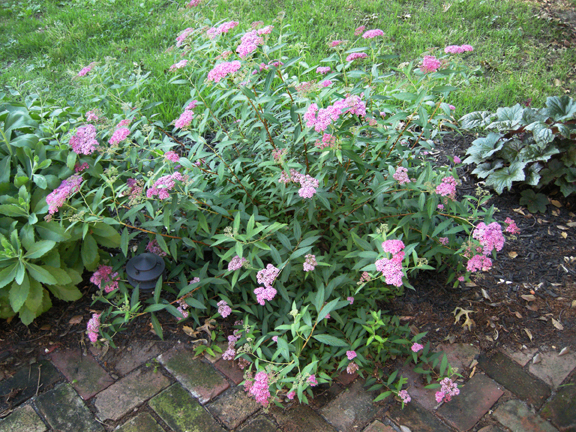Before I even owned a garden, I knew I wanted hydrangeas there. When my husband and I got married in 2008, we used a lot of cream and lime hydrangeas (both fresh and dried), in the floral arrangements. That day, although I was in madly in love with my husband, I fell head over heels for these beautiful flowers. Before my wedding when I thought of hydrangeas, I pictured the bright pink or electric blue mophead variety, so I was thrilled when our florist talked about using these flowers in gorgeous creamy whites and deep limes, many with small tinges of antique pink.
But of course hydrangeas are usually sun-loving and when I finally got my own garden it was mostly shaded. My yard only has small sections of part shade, some areas you might call part sun, and mostly shade. The only full sun in the entire yard is a tiny bed in the front of the house where I knew I wanted to plant something evergreen. So for the first year while we worked indoors, I staked out the sun patterns throughout the yard.* To my delight, I found one area in the backyard that received a decent amount of morning sun, most of the year. I was delighted because several varieties of hydrangeas actually favor morning sun.
And that is how two limelight hydrangeas became the first plants I ever planted in my garden.
My new hydrangea dilemna.
Below is a photo of my limelight hydrangeas last May, only 9 months after we planted them. Below that is a photo one year later, 22 months after we planted them. Now before I found the photograph from a year ago, I was thinking they hadn’t grow much over the last year, so I was pleasantly surprised to see how much they’ve actually grown! In the last two years they’ve also bloomed very well. I’ve only deadheaded them in late fall or early spring (limelight hydrangeas produce blooms on new stems not old wood), and left them alone otherwise. I’m quite happy with the flower production and I realize they still have a lot of growth left in them, but I’m becoming concerned about the shape they are taking. Specifically, towards the top of the shrub there are several new stems shooting upward with no forks on them. Perhaps I’m being picky here, but they are looking a little bit leggy to me. As a result, I started doing some research about pruning limelight hydrangeas and found that there are a variety of methods. I actually found so many different opinions that I’m almost more confused now than when I began. I discovered that some gardeners suggest only cutting spent blooms, others suggest pruning back to leave only two buds on each stem, others recommend only cutting back new stems every year to leave the thicker stronger stems, and then there are even others who say don’t prune it at all, just let it be.
So, who should a newbie gardener listen to? Well, here’s what I decided. First of all since it’s already June, I’m going to leave the hydrangeas alone this season and see how they look when they bloom. Then, depending on their shape with blooms present, I’ll decide if I should take action. If I do decide to prune, my plan is to take a thorough series of photographs of the hydrangeas in full bloom, then use these photographs to determine where to prune in order to encourage the fullness I’m seeking. I will probably use a variety of the suggestions above but ulitmately follow my instincts and respond to my specific plants.
Make sure to check back in late August for an update to see how they look in full bloom!
*Note: I absolutely recommend taking a full year to study and record the light patterns in your garden. I was amazed by the dramatic changes in light that I found each season. Don’t assume that a spot with full sun all afternoon in the fall will have full sun all afternoon in the spring or summer. Also, it’s good to keep in mind that full sun in the summer is much more intense than it is in the spring or fall.





